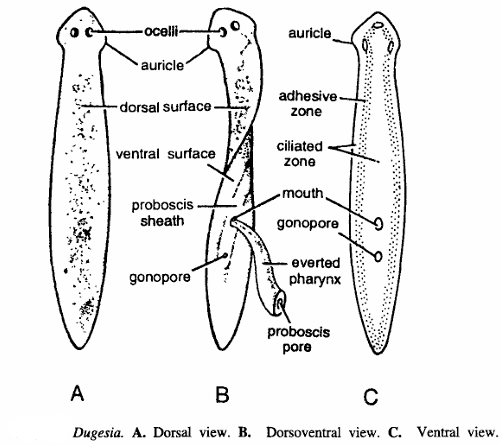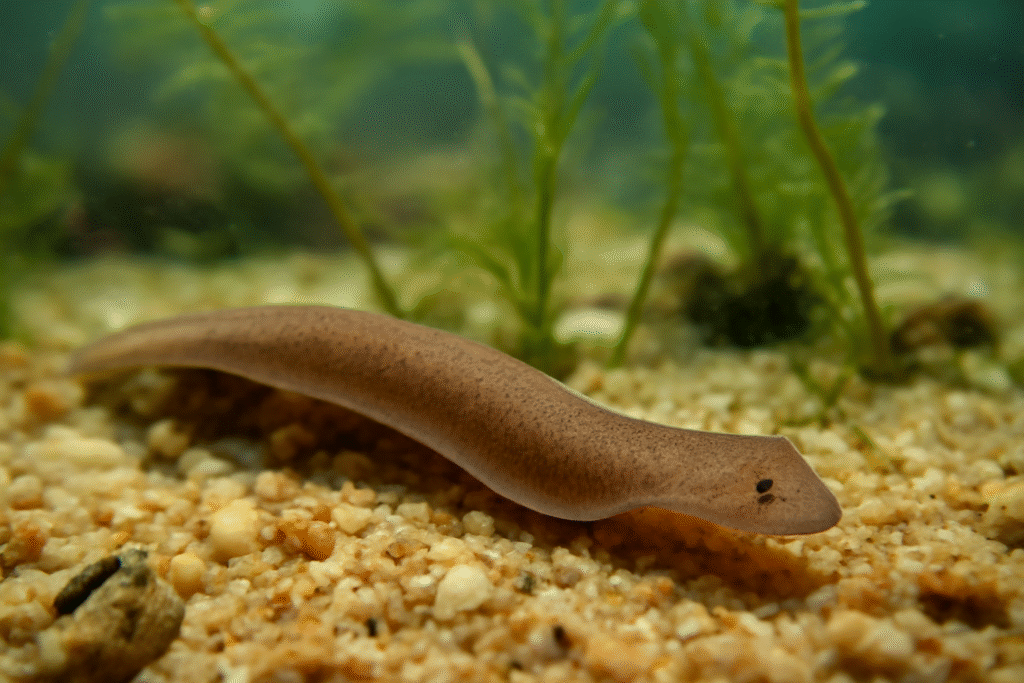Dugesia Planaria: A Comprehensive Study
Planaria, commonly known as planarian flatworms, belongs to the phylum Platyhelminthes. These are free-living, non-parasitic flatworms widely studied in developmental biology due to their extraordinary regenerative abilities. Found predominantly in freshwater bodies, Dugesia species play a critical ecological role by preying on small invertebrates and balancing aquatic ecosystems. Their simple yet remarkable anatomical features make them model organisms in scientific research.
Classification of Dugesia (Planaria)
| Classification Level | Name | Characteristic |
|---|---|---|
| Kingdom | Animalia | Multicellular, heterotrophic organisms without cell walls. |
| Phylum | Platyhelminthes | Flatworms with dorsoventrally flattened bodies and triploblastic tissues. |
| Class | Turbellaria | Mostly free-living flatworms with ciliated bodies for movement. |
| Order | Tricladida | Planarians with a three-branched digestive gut. |
| Family | Planariidae | Freshwater flatworms characterized by regenerative ability. |
| Genus | Dugesia | Freshwater planarians with a triangular head, two eyespots, and auricles. |
Species exhibit the classical characteristics of Turbellarians—bilaterally symmetrical, triploblastic acoelomates with a dorsoventrally flattened body. They possess a triangular head marked by eye spots and auricles, ciliated ventral surfaces for locomotion, and a three-branched digestive gut. These flatworms have a simple nerve net centralized into paired cerebral ganglia supporting sensory functions necessary for survival.

Habit and Habitat
Dugesia thrives in freshwater ecosystems, including clear ponds, streams, lakes, and springs with cool temperatures ranging typically from 13°C to 25°C. They are benthic creatures, often found beneath submerged stones, leaves, and detritus to escape light during the day. These nocturnal organisms feed on small animals like insect larvae, protozoans, and tiny worms, effectively controlling populations of microorganisms and contributing to nutrient cycling in freshwater habitats.
Geographical Distribution
Dugesia species exhibit a cosmopolitan distribution, predominantly inhabiting freshwater bodies across North America, Europe, Asia (notably D. japonica in East Asia), parts of Australia, and northern Africa. Their widespread presence in temperate regions reflects their adaptability to varying freshwater conditions, especially in unpolluted and oxygen-rich waters.
General Characteristics
- Commonly known as Planaria.
- Dark brown elongated cylindrical animal measuring approximately 15 mm in length.
- Body differentiated into dorsal and ventral surfaces. Ventral surface contains adhesive and ciliated zones.
- Anterior region is called as head. Head is triangular containing 2 ear like auricles on side and 2 semicircular ocelli.
- Body tapers posteriorly as a pointed end. Digestive system, consists of mouth, proboscis, oesophagus and intestine.
- Intestine is peculiar having three branches, one extending upwards and two backwards and hence the name Tricladida Mouth encircled by proboscis pore. Proboscis is highly muscular and lies in a proboscis sheath and is everted through the proboscis pore.
- Gonopore lies behind proboscis pore. It reproduces sexually and asexually.
- Body Structure: An elongated, flat body, tapering to a distinct triangular or wedge-shaped head.
- Eyespots: Present as two distinct pigmented areas at the front, aiding in light detection.
- Auricles: Lateral projections on the head rich in sensory cells that detect water currents and chemical cues.
- Locomotion: Ventral cilia enable smooth gliding on surfaces; they may also exhibit muscular contractions for swimming.
- Digestive System: A eversible pharynx connected to a tripartite gut facilitates extracellular digestion.
- Reproduction: Hermaphroditic with complex reproductive organs capable of sexual reproduction; asexual reproduction by fission is common.
- Nervous System: Paired cerebral ganglia connect to two ventral nerve cords, coordinating sensory processing and movement.
- Excretory System: Protonephridial system with flame cells regulates osmotic balance.

Special Features
Their most celebrated feature is its regenerative capacity. After injury or artificial division, it can regenerate missing body parts including the head, tail, and internal organs, a capability leveraged intensively in biology research fields exploring stem cells and tissue regeneration. Some species reproduce asexually by binary fission, splitting into two parts that regenerate entirely. Their muscular system is complex, with layers enabling precise movements, and their sensory-rich auricles aid in environmental navigation and prey detection.
Identification
The identification of species involves evaluating morphological details such as body size (3-15 mm), head shape, auricles, and pattern of eye spots. Behavioral observations like negative phototaxis and habitat preference are confirming clues. Microscopic analysis of reproductive anatomy and musculature allows differentiation at the species level. Color typically ranges from light gray to dark brown or black, aiding camouflage in aquatic environments.
Ecological Importance
- They holds significant ecological importance in freshwater ecosystems. As carnivorous organisms, they feed on small invertebrates such as insect larvae and protozoans, helping regulate populations of these aquatic organisms and maintaining ecological balance.
- Their predation contributes to controlling potential pests and ensures the stability of the food web.
- Additionally, They serves as a food source for larger aquatic animals, thus playing an integral role in energy transfer within freshwater habitats.
- Their presence is often an indicator of good water quality, since they thrive in clean, well-oxygenated environments, making them important in bioassessment and monitoring ecosystem health. Their role in nutrient cycling and organic matter decomposition further supports ecosystem functioning and biodiversity.

References
- Dugesia – Wikipedia https://en.wikipedia.org/wiki/Dugesia
- Planaria: Classification, Structure, and Nervous System – Vedantu https://www.vedantu.com/biology/planaria
- D.Tigrina: Habitat, Structure, and Locomotion – Biology Discussion https://www.biologydiscussion.com/invertebrate-zoology/phylum-platyhelminthes/dugesia-tigrina-habitat-structure-and-locomotion/28835
- Dugesia japonica – Wikipedia https://en.wikipedia.org/wiki/D_japonica
- Dugesia Punensis – Vajiram and Ravi https://vajiramandravi.com/current-affairs/d-punensis/

